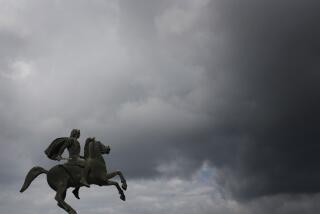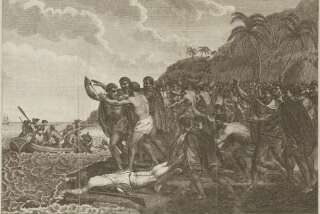PERSPECTIVE ON COLUMBUS : The Pathology of Hero-Making : Some Americans now see an evil ‘armada’ instead of an ethical hero, yet honor the rape of their West by ‘pioneers.’
- Share via
The American public remains puzzled over the significance of the Columbus celebrations, and as this Oct. 12 marks the 500th anniversary of his first voyage, some are even suggesting that Columbus Day be deleted from the calendar altogether. The navigator who once was considered the incarnation of the spirit of freedom and enterprise has been recently accused of being not only an incompetent sailor and a dishonest administrator, but also the agent of a sinister Spanish “armada” bringing injustice, slavery and death to the New World.
When, in 1988, England was celebrating the 400th anniversary of the defeat of Philip II’s Spanish Armada (the real Armada), a group of British scholars published new research on the event that for many generations had been revered as a signal victory for Protestant liberalism and English democracy against the fanatic and totalitarian Spanish Empire.
The Luke Skywalker of the time was Sir Francis Drake. Among the icons pertaining to the Armada mythology, my favorite is a Victorian painting, describing the moment in which Drake, while playing a game of bowls on the Plymouth shore, is informed that the Spanish ships are approaching; the threatening masts of the Armada can be seen on the horizon. While Drake dismisses the messenger with a cavalier gesture, the legend of the painting reads: “There is time to win the game and beat the Spanish, too.”
When the new historical findings proved that the naval disaster for Spain was caused more by adverse weather--half of the fleet was shipwrecked along the coasts of Scotland and Ireland--than by the courage or ability of the English sailors, a deep feeling of anger arose in many patriotic breasts. As an editorial in the London Times asserted, “historical pageants, national anniversary festivities should properly be concerned with projecting myths not recording facts.” Historian Sir Herbert Butterfield believed, according to the Times, that there were two kinds of history: “One which was scientifically tested and literally accurate, the other which had very little to do with what had happened but was essential to the maintenance of the nation’s spirit.”
It might be difficult to persuade the American public of the need to preserve the image of Columbus as a national hero, but it is also hard to understand how the gallant knight of yesterday has suddenly become the personification of evil. When Christopher Columbus was a romantic figurehead conveniently deprived of a specific origin or nationality, he could be the focus for national worship, but when the same character becomes a person of flesh and blood, still with obscure origins, but linked to the ignominious Spanish colonization, America pulls him from its pedestal.
In fact, many historians believe that the Spanish colonization was more concerned with ethical considerations than other, later European empires were, and that Columbus himself acted with moderation, if his conduct is to be judged by the standards of his time. Considering that 15th-Century Europe was plagued by cruelty, religious intolerance and disease, that defense of Columbus does not seem very persuasive. But it is also unfair to blame Columbus for the human and natural disasters that occurred in America centuries after his first voyage of discovery.
To get some historical perspective on the Quincentenary, it might be worth remembering that the last attempt to rehabilitate traditional Indian cultures--in the religious movement known as the “Spirit, or Ghost Dance”--was shattered by the U.S. Cavalry in Wounded Knee only two years before the Columbian Exposition of 1893 in Chicago. The Americans who erected a 14-foot monument of Columbus riding an imperial chariot were more interested in glorifying the spirit of enterprise that had achieved the country’s western expansion than in the Indian nations that were obliterated in the process. What is important to note, however, is not the difference in respect for native cultures between the late 19th Century and today, but the fact that the Wounded Knee massacre took place just over 100 years ago, while the abuses for which Columbus is blamed occurred five centuries ago.
The disruption of the Great Plains habitat and the near extinction of the American bison were provoked by pioneers who had very little in common with the values or ambitions of the Columbian world. And, while some place responsibility for the decline in population of the California Indians on the Spanish colonization and the mission system, anthropologist Robert F. Heizer has shown that the real tragedy for the Indians came between 1848 and 1870, after the Gold Rush. Although the Treaty of Guadalupe Hidalgo guaranteed Hispanics their old grants, according to research by Patricia Limerick, author of “The Legacy of Conquest,” 80% of those lands eventually fell into the hands of American lawyers and settlers. In 1850, the Foreign Miners’ Tax drove the Hispanics out of their mines.
Any assessment of an important and complex historical figure like Columbus is bound to have some of the prejudices of our times. But at least we should try to remove from our vision some of the old stereotypes that tend to blur the significance of the Quincentenary. Otherwise, we might as well adopt the Victorian motto: “There is time to bash Columbus and trash the Spanish, too.”
More to Read
Sign up for Essential California
The most important California stories and recommendations in your inbox every morning.
You may occasionally receive promotional content from the Los Angeles Times.










